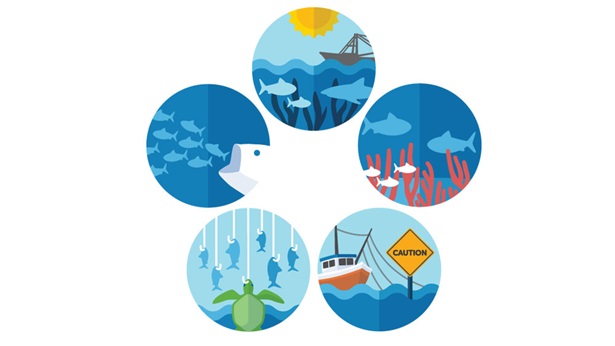Protecting Habitat
The places where fish feed, grow, and reproduce
This brief was updated on June 17, 2015 to reflect message refinements.
Fish, like all animals, need sufficient places to find shelter and food, grow, and reproduce. Healthy marine habitats ensure a sustainable supply of fish for commercial and recreational fisheries. But these essential places— including deep-sea corals, kelp forests, and seamounts—are under threat. Fishing practices such as bottom trawling or dredging can damage or destroy fragile habitat on the ocean floor. Industrial pollution and runoff can impair habitats from estuaries to the deep ocean. And nonfishing activities, such as seismic testing, coastal dredging, siting for wind farms, oil and gas development, and aquaculture production, are increasingly putting important fish habitat at risk.
Regional councils are required to work with NOAA Fisheries to identify essential habitat in their regions and minimize adverse effects from damaging fishing gear “to the extent practicable.” Too often, regional officials deem as “impracticable” scientific advice on the size of protected areas or on limiting the use of damaging fishing gear. Additionally, NOAA Fisheries is required to recommend ways to minimize nonfishing impact on fish habitat, but the relevant federal agencies, including the U.S. Army Corps of Engineers, are not required to follow the recommendations. With science as a guide, it is possible to balance the impact of fishing and other activities with the benefits of creating safe areas for fish, better ensuring that Americans have plenty to catch for decades.
The solution
As part of the reauthorization of the Magnuson-Stevens Act, Congress should strengthen conservation of fish habitat by requiring managers to:
- Protect key ocean habitats from damaging fishing activities whenever necessary, not just when practicable.
- Create habitat protection plans with measurable goals and milestones.
- Ensure that federal agencies take action to minimize the adverse effects of habitat damage to the marine environment from projects they fund, authorize, or undertake.
- Designate ecologically important “habitat areas of particular concern” for enhanced protection.
- Safeguard deep-sea corals by designating and protecting the areas where they grow.
Habitat: A closer look
Habitat influences the abundance of fish in a myriad of ways: It helps determine where the fish go, when they are there, how well they are reproducing or feeding, and how easy they are to catch. But the well-recognized importance of habitat in supporting healthy fish populations is not yet properly integrated into the nation’s fisheries management system. Identifying, conserving, and restoring essential habitat is key to supporting fishery production.
Some management councils have taken positive steps to protect select fisheries and habitats. In 2005, the North Pacific Fishery Management Council made a landmark decision to safeguard deep-sea corals from destructive bottom trawling in roughly 280,000 square nautical miles of ocean around the Aleutian Islands in Alaska—an area nearly twice the size of California. Up to 70 percent of commercially important fish species in the Aleutians were associated with these corals or sponges.1
Elsewhere, however, short-term considerations can lead to habitat damage that can take decades and sometimes centuries to heal. In New England, for instance, political pressure is mounting to open fishing areas that have been closed to bottom trawling since the 1990s. These areas are vital to the recovery of groundfish such as cod.2
Nonfishing effects on habitat can be similarly destructive. On the East Coast, proposed oil exploration using loud blasts of compressed air could injure wildlife and threaten important fish populations. The blasts from these tests could disrupt spawning areas, killing fish eggs and larvae, and scare fish away from their preferred habitat, jeopardizing their chances to reproduce and fishermen’s chances to catch them.3
Endnotes
- Jonathan Heifetz et al., Deep Sea Coral Distribution and Habitat in the Aleutian Archipelago, North Pacific Research Board Final Report 304 (2007), http://doc.nprb.org/web/03_prjs/r0304_final.pdf.
- Andrew J. Pershing et al., “The Future of Cod in the Gulf of Maine,” Gulf of Maine Research Institute (2013), http://www.gmri.org/ resources/resource-archive/future-cod-gulf-maine; and Gulf of Maine Research Institute, “The Role of Closed Areas on Cod Health” (2012), http://www.gmri.org/mini/index.asp?ID=54.
- Linda Weilgart, “A Review of the Impacts of Seismic Airgun Surveys on Marine Life” (2013), submitted to the Convention on Biological Diversity’s Expert Workshop on Underwater Noise and Its Impacts on Marine and Coastal Biodiversity (Feb. 25–27, 2014, in London), http://www.cbd.int/doc/?meeting=MCBEM-2014-01.


America’s Overdose Crisis
Sign up for our five-email course explaining the overdose crisis in America, the state of treatment access, and ways to improve care
Sign up
Adopting an ecosystem approach
View the collection for a closer look at ecosystem-based fisheries management.
Learn more





